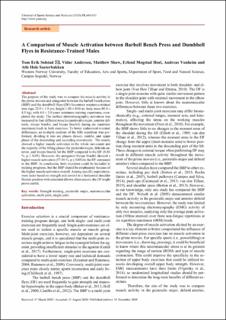| dc.contributor.author | Solstad, Tom Erik Jorung | |
| dc.contributor.author | Andersen, Vidar | |
| dc.contributor.author | Shaw, Matthew Peter | |
| dc.contributor.author | Hoel, Erlend M. | |
| dc.contributor.author | Sæterbakken, Atle Hole | |
| dc.date.accessioned | 2020-12-14T11:46:11Z | |
| dc.date.available | 2020-12-14T11:46:11Z | |
| dc.date.created | 2020-09-21T11:45:32Z | |
| dc.date.issued | 2020 | |
| dc.identifier.citation | Solstad, T. E., Andersen, V., Shaw, M., Hoel, E. M., Vonheim, A., & Sæterbakken, A. H. (2020). A comparison of muscle activation between barbell bench press and dumbbell flyes in resistance-trained males. Journal of Sports Science and Medicine, 19, 645–651. | en_US |
| dc.identifier.issn | 1303-2968 | |
| dc.identifier.uri | https://hdl.handle.net/11250/2719144 | |
| dc.description.abstract | The purpose of the study was to compare the muscle activity in the prime movers and antagonist between the barbell bench press (BBP) and the dumbbell flyes (DF) Seventeen resistance-trained men (age 22.9 ± 1.8 yrs; height 1.80 ± 0.06 m; body mass 80.0 ± 8.3 kg), with 4.8 ± 2.0 years resistance training experience, completed the study. The surface electromyographic activation was measured in four different muscles (pectoralis major, anterior deltoids, triceps brachii, and biceps brachii) during six repetition maximum loads in both exercises. To better understand eventual differences, an in-depth analysis of the fifth repetition was performed, dividing it into six phases (lower, middle, and upper phase of the descending and ascending movement). The results showed a higher muscle activation in the whole movement and the majority of the lifting phases for pectoralis major, deltoids anterior, and triceps brachii for the BBP compared to the DF (8-81 %, p ≤ 0.05). However, the antagonist biceps brachii showed a higher muscle activation (57-86 %, p ≤ 0.05) in the DF compared to the BBP. In conclusion, both exercises could be included in training programs, but the BBP should be emphasized because of the higher muscle activation overall. Among specific populations, were tasks based on strength and control in a horizontal shoulder flexion position with extended elbows often occurs, the DF might prove useful. | en_US |
| dc.language.iso | eng | en_US |
| dc.rights | Attribution-NonCommercial-NoDerivatives 4.0 Internasjonal | * |
| dc.rights.uri | http://creativecommons.org/licenses/by-nc-nd/4.0/deed.no | * |
| dc.subject | strength training | en_US |
| dc.subject | pectoralis major | en_US |
| dc.subject | neuromuscular activation | en_US |
| dc.subject | multi-joint | en_US |
| dc.subject | single-joint | en_US |
| dc.title | A Comparison of Muscle Activation between Barbell Bench Press and Dumbbell Flyes in Resistance-Trained Males | en_US |
| dc.type | Peer reviewed | en_US |
| dc.type | Journal article | en_US |
| dc.description.version | publishedVersion | en_US |
| dc.rights.holder | ©Journal of Sports Science and Medicine | en_US |
| dc.subject.nsi | VDP::Medisinske Fag: 700::Idrettsmedisinske fag: 850::Treningslære: 851 | en_US |
| dc.source.pagenumber | 645–651 | en_US |
| dc.source.volume | 19 | en_US |
| dc.source.journal | Journal of Sports Science and Medicine | en_US |
| dc.identifier.cristin | 1831588 | |
| cristin.ispublished | true | |
| cristin.fulltext | original | |
| cristin.qualitycode | 1 | |

